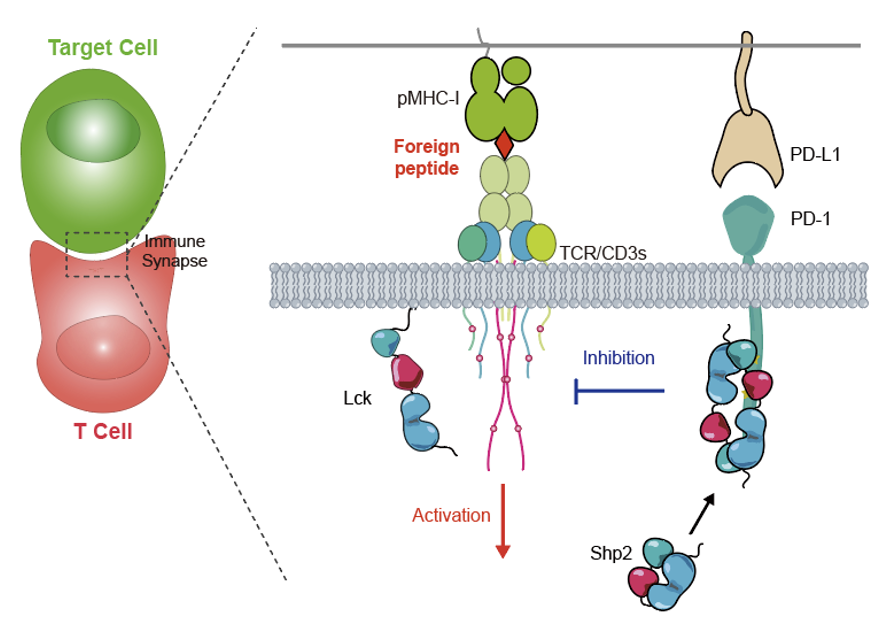Dr. Panyu Fei

Contact information
panyu.fei@kennedy.ox.ac.uk
youngfpy@zju.edu.cn
 https://orcid.org/0000-0002-3041-0479
https://orcid.org/0000-0002-3041-0479
He/His/Him
TCR/Lck/Shp2/PD-1 signalings
 ©
Private
©
Private
TCR activating and inhibiting signalings in immune synapse orchestrate T cell function
Panyu Fei
Postdoctoral Research Assistant
Journey of my intersectional scientific research
Sichuan University, China (Bachelor)
I commenced my undergraduate journey in 2011, opting for Mechanical Engineering as my major due to the belief that pursuing engineering was the most fitting path for me. Following a three-year university program and one-year practical experience in a factory setting, I successfully earned my Bachelor's degree in Engineering in 2015.
Zhejiang University, China (phD)
Upon my arrival at Zhejiang University, I discovered that my true passion lay in exploring the microscopic world, especially understanding the intricate workings of a cell in an orderly manner. Consequently, I made a shift to the development and application of biophysics methods. Over a span of three years, I dedicated myself to the development of single-molecule magnetic tweezers (MT). Subsequently, I invested another three years utilizing MT to investigate how Lck and Shp2 transitioned from an autoinhibited conformation to an activated one. This transition is crucial for transducing activating and inhibiting signals, respectively. After a challenging period of six years and three months, I successfully defended my thesis in 2021, earning my Doctorate of Philosophy degree.
Zhejiang University, China (Postdoc)
Despite the fact that my PhD study spanned over 6 years, there were still numerous tasks remaining in my projects. As a result, I decided to sign a 2-year contract with the same research group at Zhejiang University. During this time, I shifted my focus towards T cell molecular signaling, delving deeper into how TCR/Lck/PD-1/Shp2 coordinate T cell activating and inhibiting signaling networks. This research ultimately contributes to our understanding of how these molecules regulate T cell function and fate.
University of Oxford, United Kingdom (Postdoc)
Being recruited by Prof. Michael Dustin, I started my second postdoc career in University of Oxford in 2023, which was, a 2-year adventure. Here, I mainly focus on investigating TCR signaling in immune synapse. Good Luck!
6. Panyu Fei, Michael L. Dustin. Mechano-pharmacology of T cell receptor specificity. Cell Research, 2025.
https://www.nature.com/articles/s41422-025-01105-8
5. Panyu Fei, Wei Chen*. RIG-I's gating mechanism and the associated autoimmune disorders. Journal of Medical Biomechanics, 2022, 37, Supplement:104.
http://www.mechanobiology.cn/yyswlx/article/issue/2022_S1
4. Yixuan Lei#, Panyu Fei#, Bin Song, Wenjia Shi, Cheng Luo, Dahai Luo, Dan Li*, Jie Zheng* and Wei Chen*. A loosened gating mechanism of RIG-I leads to autoimmune disorders. Nucleic Acids Research, 2022, gkac361. (Co-First Author)
https://academic.oup.com/nar/article/50/10/5850/6586872?login=true
3. Panyu Fei#, Haibo Ding#, Yu Duan#, …, Zhengchun Peng*, Zhongze Gu* and Wei Chen*. Utility of TPP-manufactured biophysical restrictions to probe multi-scale cellular dynamics. Bio-Design and Manufacturing, 2021, 4: 776–789.
https://link.springer.com/article/10.1007/s42242-021-00163-2
2. Wei Hu#, Yong Zhang#, Panyu Fei#, Tongtong Zhang#, Danmei Yao#, …, Jun Wang*, Zhenhai Li*, Jizhong Lou*, Wei Chen*. Mechanical activation of spike fosters SARS-CoV-2 viral infection. Cell Research, 2021, 31(10): 1047–1060. . (Co-First Author)
https://www.nature.com/articles/s41422-021-00558-x
1. Peng Wu#, Tongtong Zhang#, Baoyu Liu#, Panyu Fei#, Lei Cui#, …, Wei Chen*, and Jizhong Lou*. Mechano-regulation of Peptide-MHC Class I Conformations Determines TCR Antigen Recognition. Molecular Cell, 2019, 73: 1015-1027. (Co-First Author)
https://www.cell.com/molecular-cell/fulltext/S1097-2765(18)31072-4

